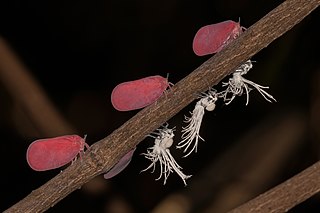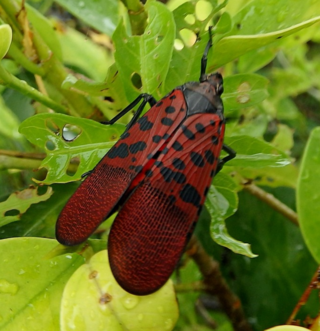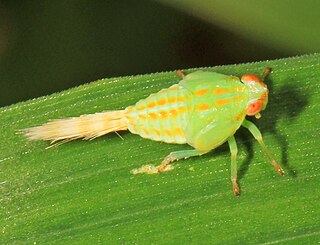
A planthopper is any insect in the infraorder Fulgoromorpha, in the suborder Auchenorrhyncha, a group exceeding 12,500 described species worldwide. The name comes from their remarkable resemblance to leaves and other plants of their environment and that they often "hop" for quick transportation in a similar way to that of grasshoppers. However, planthoppers generally walk very slowly. Distributed worldwide, all members of this group are plant-feeders, though few are considered pests. The infraorder contains only a single superfamily, Fulgoroidea. Fulgoroids are most reliably distinguished from the other Auchenorrhyncha by two features; the bifurcate ("Y"-shaped) anal vein in the forewing, and the thickened, three-segmented antennae, with a generally round or egg-shaped second segment (pedicel) that bears a fine filamentous arista.

Derbidae is a family of insects in the order Hemiptera, the true bugs. It is one of the largest and most diverse families of planthoppers. It is widely distributed around the world, especially in the tropics, and with many species in subtropical and temperate regions.

Issidae is a family of planthoppers described by Spinola in 1839, belonging to the order Hemiptera, suborder Auchenorrhyncha superfamily Fulgoroidea.

Nogodinidae is a family of planthoppers. They have membranous wings with delicate venation and can be confused with members of other Fulgoroid families such as the Issidae and Tropiduchidae. Some authors treat it as a subfamily of the Issidae. Some of their key features are a frons ("face") that is longer than wide and a reticulate wing venation. They are less than 2 cm long. The antenna arises well below the eye, has the base clubbed and flagellum unsegmented. The lateral ocelli are outside the margins of the face. The face has carinae on the edge. On the hind leg, the second tarsal segment has an apical spine arising from it. The tibia of the hind leg also has spines towards the tip. An important family character is found in the shape of the male genital structure, a style that is longer than broad. Most members of this family are forest species.

Achilidae is a family of planthoppers, sometimes called "achilids" in the order Hemiptera. There are at least 520 described species in Achilidae.

Acanaloniidae is a family of planthoppers. It is sometimes treated as a subfamily of Issidae.
The Achilixiidae are a family of Fulgoromorpha (planthoppers); species may be found in the neotropical and Asian regions.

Lycorma meliae is a planthopper species endemic to Taiwan, with multiple, dramatically different color morphs depending on the life stage. The species was described by Masayo Kato in Taiwan in 1929, and is the only member of its genus confirmed to be native to the island. In 1929, a specimen of L. meliae was originally described as a separate species, L. olivacea, also by Kato. These two taxon names were declared synonymous in 2023. L. meliae undergoes four instar stages before achieving adulthood and specimen generally only survive till the winter.

The Amyclinae are a subfamily of planthoppers in the Auchenorrhyncha, whose Basionym was first used by Zeno Payne Metcalf in 1938. The recorded distribution is the Americas, Africa, Malesia and Australia.

Thionia quinquata is a species of issid planthopper in the family Issidae.

Thionia elliptica is a species of issid planthopper in the family Issidae.
Cheiloceps is a genus of planthoppers in the family Issidae. Cheiloceps was described as a genus by Uhler, 1895, downgraded by Fennah, 1955 to a subgenus of Thionia; then restored to genus status by Gnezdilov, 2018.
Waorania is the only genus of issid planthopper in the subtribe Waoraniina. The first two species in the genus were discovered in the forests of Ecuador.
Amnisa is a genus of issid planthopper in the family Issidae and are native to Brazil.
Diceroptera is a genus of issid planthopper with one species, Diceroptera humboldti. It can be found in Venezuela.
Dracela is a genus of issid planthopper in the family Issidae and can be found in northern South America and southern Central America.
Oronoqua is a genus of issid planthopper in the family Issidae and can be found in the northern Neotropics. The difference in fore and hind wing venations between species of Oronoqua and the other genera in Thioniini led to a subtribe Oronoquina being erected.
Paranipeus is a genus of issid planthopper containing one species, Paranipeus latipes, native to Brazil.
Proteinissus is a genus of planthopper in the family Issidae, found in Mexico.
Thioniamorpha is a genus of issid planthopper with one species, Thioniamorpha marmorata, found in Panama.









